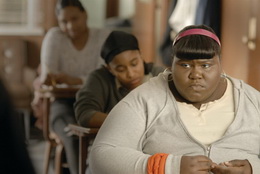
I can't imagine what new thing I could add to the conversation about Precious (2009) at this late date, especially as a human or social document, of which it is a profoundly powerful example. So I will confine myself to a couple of strictly film-oriented observations and urge you to see if it you haven't.
A note about that. I suspect many people avoided the film, as I did, because it looked like one of those ponderous downer indie films. And the marketing emphasized the suffering of the main character and never revealed her transcendence. When you see a trailer or an interview for The Blind Side, you can't miss the fact that it's all going to turn out OK, that, in fact, you're going to feel great when the film is over. The marketers for Precious didn't do that, and as well as the film did, I can't help suspecting it had blockbuster potential if it had been positioned more astutely.
The film has some of the most beautiful and thoughtful framing and staging in a long time. I looked for a long time without success for a screen grab of my favorite shot in the film--again, the publicists have limited themselves to a handful of pictures, mostly showing lead actress Gabourey Sidibe scowling. It happens when Precious arrives for her first day of classes at the alternative high school and the language teacher, Ms. Rain saunters into the hall for a soda. The camera remains stationary, keeping both the foreground chair Precious is sitting in and the hall which recedes toward the classroom in focus. The teacher invites Precious to join the class, but Precious, who has just vomited up her gobbled-down breakfast, doesn't move. The teacher walks partway back, but out of Precious's line of sight. And she leans on the wall, waiting. Precious still sits sprawled. At the moment, each is in their own sphere, hovering on the brink of connecting. And director Lee Daniels has the sense to let us have a moment to contemplate that.
A moment later, Precious will take the steps to change her life and as she does, there is a blinding white light, which settles into the warm, brown inviting tones of the classroom. It is impossible to miss this is a milestone.
The transitions into Precious's fantasies are all marvelous and inventive, especially for this old trope (I mean the troubled youngster escaping into fantasy.) There are two uses of special effects in the movie and both of them are dazzling. At one point, Precious looks through a cross-shaped window in a door and the camera moves through it to a digital snowstorm against black and then we move to the next scene. I don't know what it meant, except that it connects all these separate realities. Then later, in the halfway house, Precious looks out the window and sees a young man on a motorcycle who could conceivably be a boyfriend (she's never had one). And the stones in the asphalt of the street glitter like stars until we fade into reality. That should have seemed silly, laughable, but it is profoundly expressive.
One quibble--one day Precious is barely writing intelligible words. A few movie minutes later (it is supposed to be months later) she is winning an award for her poetry. It stretches credulity, but it wouldn't have stretched it if we could have heard some of that poetry, which would also have given us more detailed insight into Precious's inner growth.
Finally, the director has to be credited with the high level of acting in the film, given that only one of the principals (Paula Patton) is a full-time, trained actor. The rest, newcomer Sidibe, Mo'nique, Mariah Carey, Lenny Kravitz, Sherry Shepherd come to acting from other places, most from other types of performing which call on them to project the best, most likeable version of themselves. Obviously, that was not what they were called upon to do in Precious, but everyone delivers superbly, right down the line. Think of the climactic scene between Sidibe, Mo'nique and Mariah Carey--a scene which seasoned pros would find intimidating. These three neophytes breezed through it like nothing.
This could indicate the skill of the director; his good sense and judgment in making and cultivating friends (which is how he cast many of the non-actors); or that they didn't know to be afraid of a scene like that because they lacked experience. A hard scene was just as hard as an easy scene, and vice versa. But it also says something about film acting. It only has to be done once. It could be argued that the only reason an actor needs technique is in order to be able to repeat a performance, whether for different audiences in the theater or for different takes in the movies. If you only have to do it once--and in these days of digital photography, it makes sense to shoot with multiple cameras to get coverage--perhaps all that is required is some intelligence, sensitivity and imagination, and the old virtues of technique are less important. It's happened before--think of Harold Russell in The Best Years of Our Lives or Oprah Winfrey in The Color Purple--but I can't think of another movie so thickly populated with fine performances by non-actors.
If Lee Daniels weren't already past 50, I would say he was a youngster to watch.





No comments:
Post a Comment